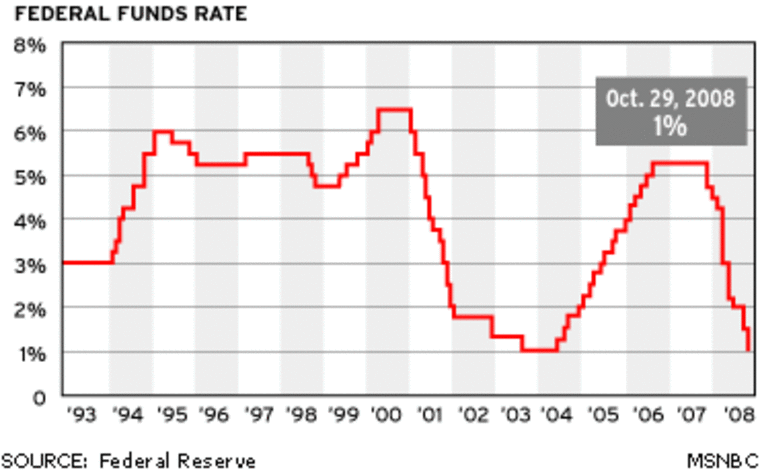The Federal Reserve raised interest rates Tuesday for a fifth and presumably final time this year and signaled that it intends to continue pushing up borrowing costs for businesses and consumers at a "measured" pace.
Fed Chairman Alan Greenspan and his fellow policy-makers raised the overnight federal funds rate a quarter-percentage point to 2.25 percent, extending their campaign to restore borrowing costs to more normal levels after a period of unusually low rates.
The Fed has raised short-term lending levels by 1.25 percentage points since beginning its tightening cycle in late June, when the federal funds rate was at a 46-year low of 1 percent. The Fed's decisions influence a range of other short-term rates including the prime rate, for top business and individual customers, which leading banks raised to 5.25 percent after the latest move.
The rate hike was widely anticipated, although stock prices jumped shortly after the 2:15 p.m. announcement. Broad market indicators ended the session with a gain of about 0.4 percent.
Investors were relieved the Fed did not express any new concerns about inflation or economic growth, said Tony Crescenzi, chief bond market analyst for Miller Tabak & Co. A report that next year also contributed to the afternoon rally, he said. (MSNBC is a joint venture of Microsoft and NBC, which is owned by GE.)
In announcing the latest decision of its rate-setting Open Market Committee, the Fed used language nearly identical to comments issued after its previous quarter-point hike in November.
"The committee believes that even after this action the stance of monetary policy remains accommodative, and coupled with robust underlying growth in productivity is providing ongoing support to economic activity," the Fed said. "With underlying inflation expected to be relatively low, the Committee believes that policy accommodation can be removed at a pace that is likely to be measured."
The comment was widely interpreted as confirming market expectations that the central bank will raise rates another quarter-point Feb. 2, when it concludes its first meeting of 2005.
"My suspicion is they see themselves as simply getting back to what they see as even keel," said John Silvia, chief economist of Wachovia Securities.
He believes the Fed will raise rates by a quarter-point again in February and in March.
"They don’t see themselves in a rush — inflation is not accelerating," Silvia said. "Nor are they just sitting back and saying we need to stop raising rates because the economy is weakening."
In fact, inflation has accelerated slightly this year, and economic growth is expected to slow next year from this year's robust pace. But the Fed is simply not worried, said Crescenzi, of Miller Tabak.
He points out that since the Fed began raising rates June 30, the stock market has risen, the dollar has fallen and long-term interest rates have fallen — all factors that stimulate the domestic economy. These factors make it "extremely likely that the Federal Reserve will have to raise interest rates at least several more times before it can consider its job done," he said.
Other economists vigorously are debating when and whether the Fed will pause in its rate-hike campaign next year.
“One of the issues here is speed, and the other issue is endpoint — not only how fast they are going to go but how far are they going to go,” said Tim O’Neill, chief economist for BMO Financial Group.
Inflation has edged up only modestly this year, while the economy has turned in its strongest performance since the late 1990s. But the falling dollar has triggered some concerns of faster inflation that could force the Fed to step up the pace of rate increases just as economic growth is slowing.
"From here on out, it’s about a pre-emptive strike against mounting inflationary pressures," said Richard Yamarone, director of economic research at Argus Research.
On Tuesday the government reported that the U.S. trade deficit rose to a record $55.5 billion despite the weaker dollar, which boosted exports but failed to dampen imports.
Economists believe the Fed is trying to find a so-called “neutral” level for the federal funds rate, which would allow the economy to continue to grow at its typical speed and push down unemployment at least modestly without triggering inflation. But there is considerable debate about what that “neutral” level is.
O’Neill predicted the Fed ultimately would push the benchmark level to 4.5 percent by the end of 2006, but others believe the rate will peak well before that. Many Fed-watchers say Greenspan, who is scheduled to step down in early 2006 after nearly two decades in his immensely powerful position, is anxious to avoid repeating a mistake of 1994-95. At that time the Fed tightened credit rapidly and nearly choked off what turned out to be a record decade-long expansion.
The Fed also said Tuesday it would speed the release of minutes describing the debate at meetings of the policy-making Open Market Committee. The Fed now plans to release minutes after a lag of just three weeks, rather than about six weeks under the previous system.
That will give financial market participants more current insight into the thinking of Fed policy-makers on economic trends and rate decisions.
The new system will begin with minutes from Tuesday's meeting, which are scheduled to be released Jan. 4.
